Nikon Coolpix P500 Review
Nikon Coolpix P500
Nikon's latest 'mega zoom' just edges ahead of its Canon SX30 IS rival by offering a huge 36x optical reach. But can its performance keep up?
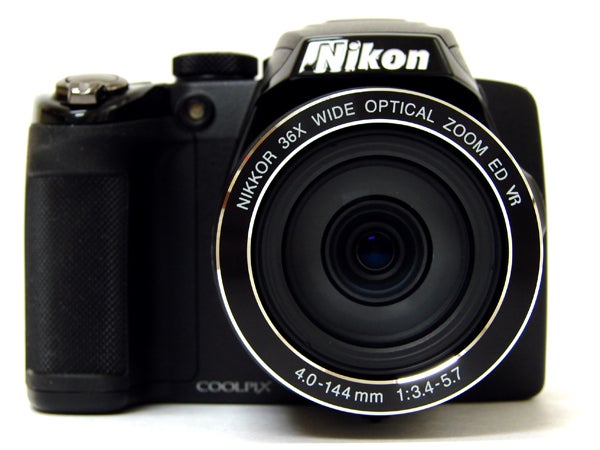
Verdict
Pros
- Class-leading 36x zoom lens
- Full HD video with stereo sound
- Flip out screen
- Full manual controls
Cons
- Mediocre image quality
- Bulky
- Same price as entry level DSLR
Key Specifications
- Review Price: £343.00
- 36x zoom lens (22.5 - 810mm)
- Full HD video with stereo sound
- Flip out screen
- Full manual controls
The Nikon Coolpix P500 is the company’s latest super zoom for those who require the broadest possible focal length range in the most compact chassis. Replacing the P100 which offered a mere 26x zoom, it just nudges ahead of its chief competitor, the PowerShot SX30 IS, by virtue of offering a gargantuan 36x optical reach (to the Canon’s ‘paltry’ 35x). Accompanying this mammoth zoom is a 12.1 megapixel back illuminated CMOS sensor, which should theoretically provide greater low light effectiveness. Other competitors include the Fujifilm HS10 and newly introduced FinePix HS20 plus the existing Olympus SP800 UZ, all of which offer 30x zoom. 
Not to be confused with the co-announced P300 compact, in trying to be all things to all men, the focal range on the P500 provides a 35mm equivalent of an ultra wide angle 22.5mm to 810mm at the telephoto end with f/3.4 maximum aperture. Conversely, also useful is the ability to shoot as close as 1cm for macro photography. Unusually, there’s not only a zoom lever encircling the main shutter release button on the top plate, but we also get a second zoom control set into the side of the lens barrel at the front, the action of which is slightly slower and steadier when needed. Of course, the big advantage of this is that it doesn’t disturb video recording, for which a thumb-operated record button is provided at the back. This is encircled by a lever for instantly swapping between standard def slow motion clips – very smooth and effective as it happens – and Full HD 1080p footage at 30fps.
Of course shooting at the telephoto end of such an extensive focal range is bound to make camera shake an issue. Here Nikon proposes to have dealt with it via a combination of sensor shift image stabilisation plus the electronic ISO and shutter speed boosting variety. That said, light sensitivity maxes out at a fairly typical ISO3200. Further blur avoiding techniques include motion detection technology, a Best Shot Selector, and Night Portrait and Night Landscape modes.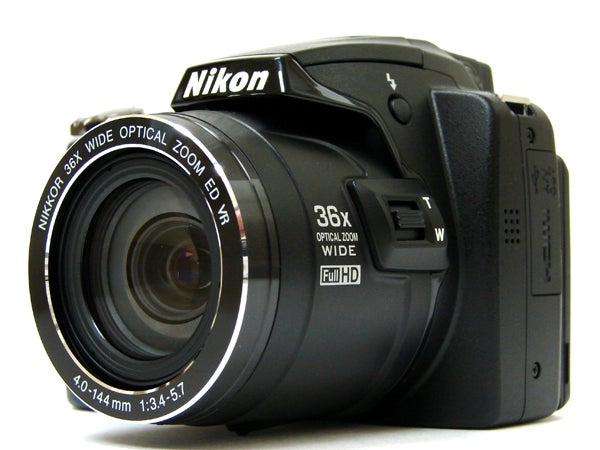
It would be criminal if the optical zoom was limited to just shooting photos, and happily that’s not the case here. Even though there is a bit of an operational buzz, it can be utilised when recording Full HD 1080p video, which boasts stereo sound and HDMI output as standard, the camera’s AF automatically adjusting as the user zooms. A feature increasingly offered by rival manufacturers is included here too; namely the ability to shoot slow motion video clips, here at speeds of up to 240 fps – which combined with that class leading lens range makes this a great camera for recording amateur sporting events. Continuous/burst shooting (up to 8fps at full resolution) also gets its own top plate button for rapid-switching convenience, and the creative quartet of program, aperture priority, shutter priority and manual shooting settings are located around a usefully chunky top plate dial.
Available in studious looking black only, with a manufacturer’s suggested price of £399.99, at the time of writing P500 prices were £50 cheaper, bringing it almost exactly into line give a penny or two with the street price of Canon’s SX30 IS. At this price, it’s stepping firmly on the toes of entry level DSLRs with their standard kit lenses, such as Nikon’s own D3100, and those cameras will certainly provide better image quality. But, of course, where a standard kit lens has around 4x zoom, the P500 ”slightly” out does that (and any sort of DSLR lens that comes close to that range of zoom will set you back over £500 alone). Not to mention, the P500 is also considerably more compact.
The Nikon P500 is lighter than its Canon rival, being 494g with battery and optional SD/SDHC/SDXC card inserted, compared with 601g for the SX30 IS when also fully loaded. As we mentioned at the outset, the P500 is very much styled to look like a mini DSLR, the theory behind it being that, like all super zooms, the lens here is so versatile that you won’t mind the fact that unlike that of a DSLR proper it cannot be swapped. The bulk is such that this is a tool for your camera bag rather than a pocket, with a shoulder strap included in the box. You’ll also find therein a lens cap of the clip-on variety, which can also be attached to a vacant lug to avoid losing it. Like the vast majority of superzooms the overall build is a little plastic-y, but this is well disguised by the black finish and the construction feels surprisingly solid – enough to withstand the odd accidental knock – when held in the palm.
The chunkier proportions ensure that it’s possible to comfortably snake three fingers around the Coolpix’s substantial grip, with roughed surface to further prevent slippage, and not have your knuckles scrape against the adjacent lens barrel. For composition and review Nikon has also very usefully thrown in an angle adjustable 920k dot resolution, 3-inch LCD screen at the rear with electronic viewfinder (EVF) sitting directly above. This proved especially useful during our test period when attempting shots low to the ground, as the screen can be tilted up so you are looking directly down on it. 
Said LCD cannot however be flipped outwards through 180° to one side, or rotated so the screen is facing body inwards like the Canon SX30 IS, so the flexibility has its limitations. The resolution is however far better than the Canon’s so-so 230k dots. A button is provided top left of the EVF for instantly switching between the two, although we really missed having an eye sensor to automatically perform the same function. For practicality’s sake and greater choice of framing we found ourselves heavily reliant on the back screen anyway, which didn’t particularly seem to suffer in the usual bugbear of bright sunlight.
The controls on the P500 are all well labelled, for the most part large enough and fall readily beneath finger tip or thumb. The backplate looks like a cross between a compact camera and an entry level DSLR – which is a fair way to sum up the P500 in general. It provides both a rear DSLR-like command dial for quickly scrolling through selectable shutter speeds plus four-way control pad with ‘OK’ button at its centre for implementing any changes to menu settings, for which a dedicated menu button is placed directly below. While we would have liked a button for direct access to ISO options, we also get dedicated delete, playback and display setting buttons – again pretty much what you’d expect to find on any compact camera. So those trading up from a point and shoot snapshot camera won’t find the P500 daunting when it comes to day to day operation.
Press the P500’s on/off button, attractively illuminated in green when active and continuing to ‘pulse’ when the camera is in sleep mode, and the Nikon powers up in just over a second, rear LCD blinking almost instantly into life. In tandem the lens barrel nudges forward slightly from its protective housing to arrive at the maximum wideangle setting. 
Squeeze the shutter release button down halfway and the autofocuss completes its job after the briefest of pauses. Depress the button fully to take the shot and a full 12 megapixel highest quality JPEG is committed to memory in just under two seconds, which is fast by compact camera standards. There’s no raw option here, which could be a deal breaker for some. Generally we found the P500’s focus and exposure to be spot on, if anything erring towards a slight underexposure in order to preserve highlight detail. Images are surprisingly sharp as well, being a match for some premium end compacts, if the P500 doesn’t quite possess the same extensive feature set in terms of creativity.
Using the top plate zoom lever the Nikon whirrs through its extensive optical range in around four seconds. Alternatively use the side lever on the lens barrel to perform the same function and you can add a second and a half onto that but there’s less obvious operational noise, which is obviously a boon for video clips.
The P500 boasts a light sensitivity range starting out at a manually selectable ISO160 and topping out at ISO3200. We also get both Auto ISO and separate auto high ISO sensitivity and fixed range auto ISO settings, the latter allowing the ISO range to be limited to a modest ISO160-200 or ISO160-400, so there’s absolutely no chance of noise degrading the shot. As it transpired during our test period the P500 keeps noise/grain well under control, detail softening and the image beginning to fall apart not until the very top ISO3200 setting, which is fairly impressive stuff as long as you don’t mind a bit of softening to disguise the gritty look at higher ISOs.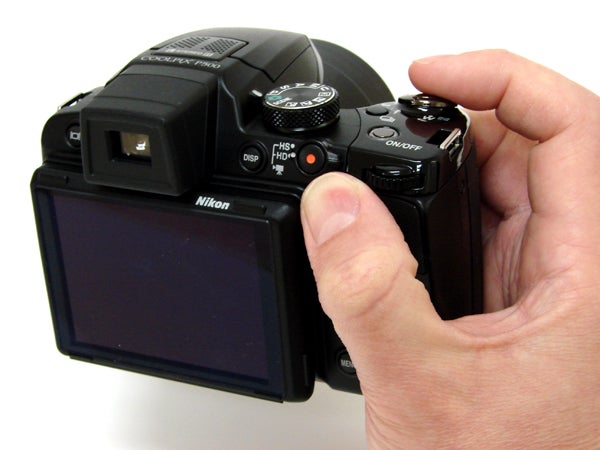
When it comes to general shooting the usual bugbears raise their heads. Which is to say there is some softening of detail towards the edges of frame – not totally surprising, given the ultra wide wideangle setting here – and also some purple pixel fringing noticeable between areas of high contrast. The latter, along with the fact that it took us sometimes two or three attempts to get us anything other than a soft shot handheld at maximum telephoto, is probably the biggest issue with the camera, but as we say it’s far from uncommon. Take a look at our test shots to see whether the above are ‘issues’ you can live with if you’re thinking of buying a P500.
”’Verdict”’
If you’re after a truly super, superzoom then you can’t get much better than the Nikon P500. It’s 36x zoom is quite simply one better than the competition, spanning as it does a range of 22.5 – 810mm (in 35mm terms). With Full HD video, including stereo audio, and a full set of manual exposure controls, it’s also a versatile tool. Add in a reasonably competitive price and you’ve got a near perfect site seeing/travel companion. For build quality and its manually adjustable lens we’re still more keen on the Fuji HS10, but that is an even bulkier camera and doesn’t have quite the zoom range.

The Nikon Coolpix P500 offers a light sensitivity range starting out at a manually selectable ISO160 and topping out at ISO3200. We also get both Auto ISO and separate auto high ISO sensitivity and fixed range auto ISO settings, the latter allowing the ISO range to be limited to a modest ISO160-200 or ISO160-400, so there’s absolutely no chance of noise degrading the shot. Let’s see how the Coolpix gets on with our standard test set up, shot using a tripod, available light at the highest JPEG resolution and utilising auto white balance.
—-
—–

Apart from the auto settings, the lowest user selectable setting on the S3100 is ISO160, a little higher than most contacts that start out either at ISO80 or ISO100. As we’d expect there’s no noise visible anywhere in the image and moreover it’s commendably sharp and detailed.
—-

Up a notch at ISO200, a setting that hardly seems worth having so incrementally close is it to the lowest available setting. As expected it’s therefore very hard to tell the difference between this clean image and the one shot at ISO160.
—-

We’re at ISO400, the setting at which noise begins to creep into shadow areas on lesser compacts. That’s not the case with the P500 but there is an ever so slight softening of detail on close scrutiny between this and the previous setting.
—-
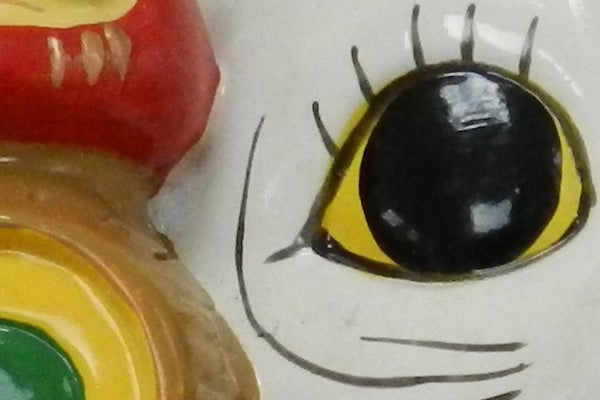
You wouldn’t notice the difference between ISO400 and ISO800 when viewing the full frame, but crop and enlarge a section and edge detail is softening and becoming slightly pixellated.
—-
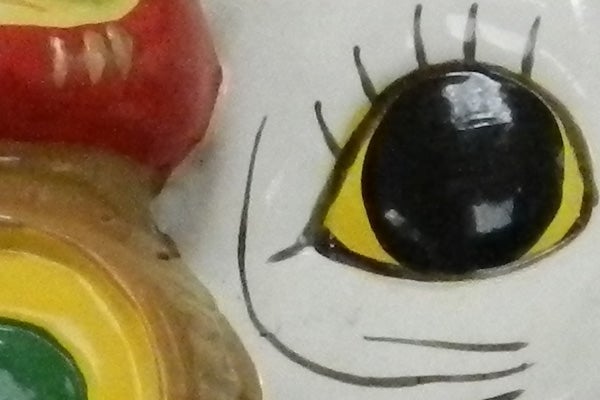
Again at ISO1600 the entire image looks clean unless you’re zooming in to check detail, whereupon you notice it’s softer still over ISO800 as is to be expected, but this hasn’t quite disguised the fact that noise is more noticeably intruding into shadow areas.
—-

At the top setting of ISO3200 you don’t have to enlarge anything to tell that the image is softer overall and taking on a grainy appearance. That said, the performance of the P500 is well up there with what the keen amateur enthusiast would expect from this sort of investment and class of camera.
—-
A more general selection of test shots are revealed on this page and next to act as an evaluation of the Nikon Coolpix P500 in a variety of shooting conditions, and the quality attainable when shooting at extreme wide angle and maximum telephoto – since here the broad focal range is the camera’s main selling point.
—-

This extreme wide angle composition, shot at ultra wide 22.5mm equivalent, shows how much can be shoehored into frame with the P500. If we’re being picky there is some softening of detail towards the edges of frame and also some pixel fringing noticeable in the top left hand corner where the tree branches meet the sky – but neither are complete surprises.
—-
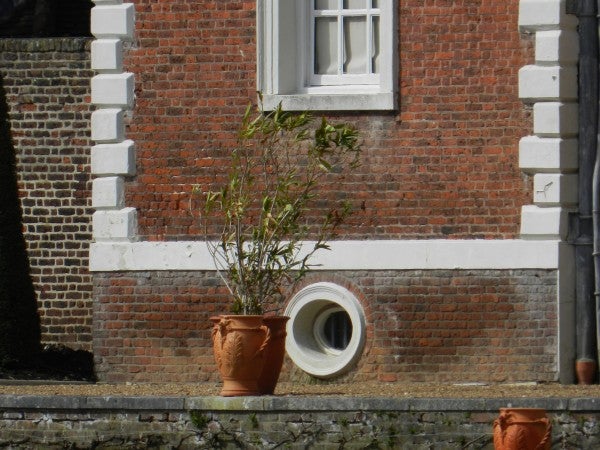
A second image taken from the same vantage point but now at the telephoto end of the zoom (810mm equivalent) to display the breadth of the focal range on offer; you can almost witness the lady of the house picking her nose. This shot is a little softer overall. Generally we struggled to get pin sharp images shooting handheld at this setting and found it best to have two or three attempts.
—-

Our regular rusty gate shot taken toward the telephoto end of the zoom, but of a much closer subject. There’s sufficient detail here to display the flaky paint and rusting metal, though if we’re being picky there is a purple-ish hue to the sky in this image.
—-

A brick wall may not make for a stunning visual in itself, but it’s here as a good example of the level of detail that can be delivered by the P500’s lens and sensor combo. Here the weathered fascia is captured in all its glory in this wideangle shot which displays surprisingly little barrel distortion.
—-

And by contrast another handheld shot taken at the extreme telephoto end of the zoom. Whilst again it’s a little softer than we might have liked, part due in fairness to movement of the goose’s neck, there is sufficient detail rendered nonetheless to be able to pick out the pattern of the feathers.
—-
Here are some general test shots taken with the Nikon Coolpix P500 to give an idea of performance ability when it comes to image quality, dynamic range, colour rendition and the focal range provided.
—-

Again, as with our rusty gate shot the mix of pink and blue has resulted in a slight purplish hue to this daylight image, but having said that we’ve still got bags of detail front to back of frame. If anything, we found the default colours from the P500 are a little more subdued than that of the actual subjects, though an automatic saturation boost can be delivered by switching to landscape mode.
—-
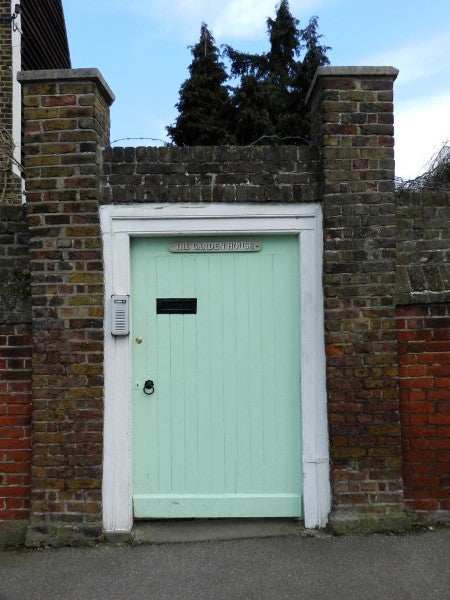
Another case in point is this green door which is more vivid still in real life than shown here. While there’s some purple fringing again around the edges of the tree top centre of frame, the eye is instead drawn to the intricate detail captured in the brickwork and paintwork of the door frame here.
—-

OK, now we’re being particularly cruel and displaying a subject that reveals the common bugbear of pixel fringing between areas of high contrast, most noticeable in the bottom left hand quarter of the frame. Again though we can’t knock the level of detail captured.
—-

We took full advantage here of the P500′ s adjustable LCD screen, tilting it upwards through 90° we could look down on it as we took the shot. This is obviously a wideangle image, the leaning verticals also the product of the low angle where we were looking up at our subject for added dynamism.
—-
Trusted Score
Score in detail
-
Value 8
-
Image Quality 8
Features
| Camera type | Digital SLR |
| Megapixels (Megapixel) | Megapixel |
| Optical Zoom (Times) | 12 Xx, 36 Xx |
| Image Sensor | CMOS |
| Image Stabilisation | Optical |
| LCD Monitor | 3 in |
| Flash modes | Auto Flash, Flash OFF, Flash ON, Red-eye Reduction, Built-in Flash |
| Video (max res/format) | 640 x 480, 1920 x 1080 |

